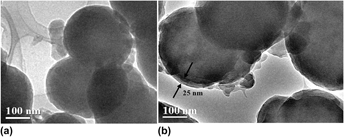Article contents
Preparation and characterization of thermosensitive core/shell microgels with carbon microsphere cores
Published online by Cambridge University Press: 12 May 2014
Abstract

A novel thermosensitive core/shell microgel with carbon microspheres (CMSs) cores was prepared by three steps. First, oxidized-carbon microspheres were obtained by mixed-acid oxidization. Second, the silane agent of 3-(trimethoxysilyl)-propyl methacrylate was used to functionalize the oxidized-carbon microspheres so as to generate the vinyl groups on the microspheres. Thereafter, the as-synthesized particles were used as seeds in the precipitation polymerization of N-isopropylacrylamide to introduce a thermosensitive polymer microgel shell onto the surfaces of the silanized-CMSs in the presence of an initiator and a crosslinker. The morphology and thermosensitive properties of the composite microspheres were characterized by field emission scanning electron microscopy, transmission electron microscopy, Fourier transformation infrared spectroscopy, thermogravimetry, and dynamic light scattering. Results indicate that the thickness of polymer layer could be adjusted by the crosslinking agent's concentration. The composite microgels had a low critical solution temperature at about 30 °C and exhibited strong thermosensitivity. The controlled release of a drug molecule (a model drug, acetosalicylic acid) was also investigated.
- Type
- Articles
- Information
- Copyright
- Copyright © Materials Research Society 2014
References
REFERENCES
- 8
- Cited by


